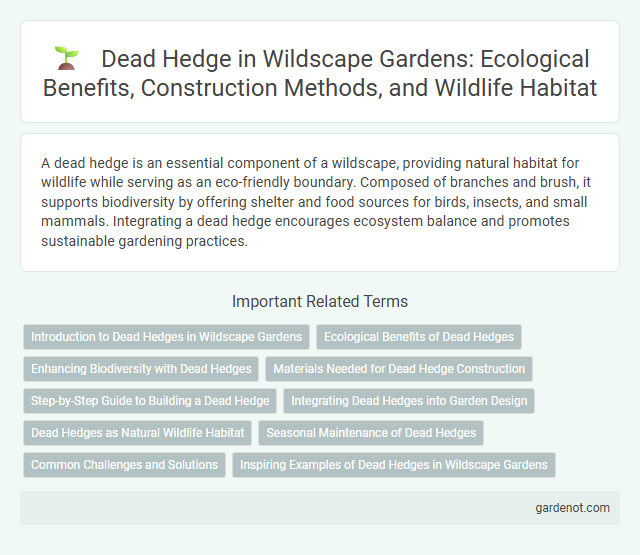A dead hedge is an essential component of a wildscape, providing natural habitat for wildlife while serving as an eco-friendly boundary. Composed of branches and brush, it supports biodiversity by offering shelter and food sources for birds, insects, and small mammals. Integrating a dead hedge encourages ecosystem balance and promotes sustainable gardening practices.
Introduction to Dead Hedges in Wildscape Gardens
Dead hedges in Wildscape Gardens serve as vital ecological structures, composed of interwoven branches and twigs, providing shelter and nesting habitats for a variety of wildlife, including birds, insects, and small mammals. Their dense, natural barriers play a crucial role in soil conservation and habitat connectivity, supporting biodiversity within the garden's ecosystem. By mimicking natural woodland edges, dead hedges enhance the ecological value of Wildscape Gardens, promoting sustainable conservation practices.
Ecological Benefits of Dead Hedges
Dead hedges provide critical habitats for a variety of wildlife, including insects, birds, and small mammals, enhancing biodiversity within natural landscapes. They act as natural barriers that reduce soil erosion and improve water retention, contributing to ecosystem stability. By recycling organic material, dead hedges enrich soil fertility and promote sustainable land management in wildscape conservation efforts.
Enhancing Biodiversity with Dead Hedges
Dead hedges create essential habitats for insects, birds, and small mammals, significantly boosting local biodiversity within wildscapes. These structures promote natural decomposition processes and offer shelter, nesting sites, and food sources that support complex ecosystems. Integrating dead hedges into land management fosters ecological balance and strengthens wildlife corridors crucial for species movement and survival.
Materials Needed for Dead Hedge Construction
Constructing a dead hedge in Wildscape requires natural materials such as branches, twigs, and hedge cuttings collected from native trees and shrubs to encourage biodiversity. Incorporating brash, leaves, and thicker logs provides essential habitats for insects, small mammals, and birds. Using locally sourced, untreated wood ensures environmental sustainability and supports the natural ecosystem.
Step-by-Step Guide to Building a Dead Hedge
Creating a dead hedge involves layering cut branches and plant material to form a natural barrier that supports wildlife habitats and prevents soil erosion. Start by selecting a suitable location, then lay larger branches at the base, gradually adding smaller twigs and leaves on top to fill gaps and promote decomposition. Secure the structure with stakes or wire to maintain stability, ensuring it provides shelter for insects, birds, and small mammals while enhancing biodiversity in the wildscape.
Integrating Dead Hedges into Garden Design
Dead hedges serve as natural barriers and habitats, enhancing biodiversity within garden design by providing shelter for birds, insects, and small mammals. Incorporating dead hedges made from locally sourced branches and twigs enriches soil health through gradual decomposition while maintaining an eco-friendly aesthetic. Strategic placement along borders or partitions supports wildlife corridors and promotes a sustainable, wildlife-friendly landscape.
Dead Hedges as Natural Wildlife Habitat
Dead hedges provide essential shelter and nesting sites for a variety of wildlife species, including birds, small mammals, and insects. These structures promote biodiversity by offering safe refuges and corridors that connect fragmented habitats. By mimicking natural brush piles, dead hedges enhance ecosystem health and support pollinators, predators, and decomposers crucial for soil fertility.
Seasonal Maintenance of Dead Hedges
Seasonal maintenance of dead hedges involves clearing accumulated debris, trimming encroaching vegetation, and reinforcing the structure to ensure durability and habitat value. Performing maintenance during late winter or early spring optimizes plant material quality and encourages new growth while preserving shelter for wildlife. Regular upkeep enhances the ecological benefits of dead hedges, supporting biodiversity and natural pest control.
Common Challenges and Solutions
Dead hedges often face challenges such as deterioration due to weather exposure, encroachment by invasive species, and incomplete habitat connectivity. Regular maintenance, including reinforcing structures with fresh cuttings and controlling invasive plants, enhances their durability and ecological function. Integrating dead hedges within a broader habitat network improves wildlife corridors and biodiversity support.
Inspiring Examples of Dead Hedges in Wildscape Gardens
Dead hedges in wildscape gardens showcase natural fencing made from interwoven branches and twigs, enhancing habitat connectivity for wildlife such as hedgehogs and birds. These structures improve soil health by promoting decomposition and provide essential shelter sources for insects and small mammals. Prominent examples include the Royal Botanic Gardens' dead hedge in Kew, which supports biodiversity while maintaining an aesthetically pleasing natural boundary.
Dead hedge Infographic

 gardenot.com
gardenot.com